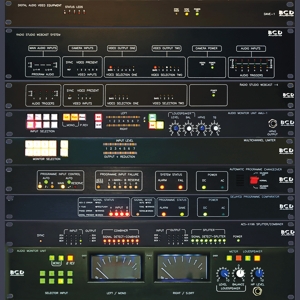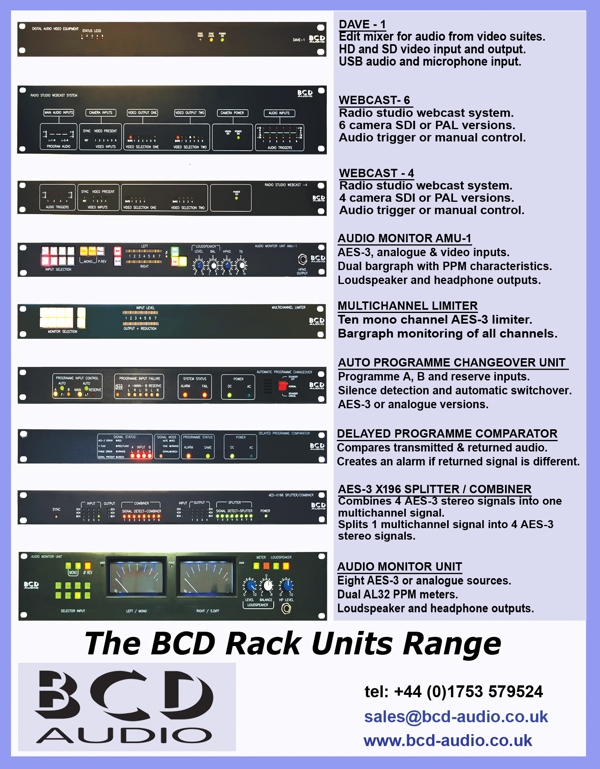 The BCD Audio Rack Mount Range.
The BCD Audio Rack Mount Range.
The BCD Audio Rack mount range fits between the Black-Box and Eurocard range of products.
The units have been designed to fulfil specific applications, not often found elsewhere. BCD specialise in designing products to fit the exacting requirements of our customers, so are always happy to expand the range when required.
Most units have mains and 12V DC power. This reduces cost for regular single mains installations, but allows economical dual-redundant use when required.
DAVE-1
This 1U unit takes in SDI SD/HD video , and de-embeds up to 8 audio signals. The DSP mixes these with a local microphone , audio from a PC via USB, and re-embeds up to 8 audio signals. Audio is also output to the PC via USB, and to AES-3 outputs. SRC’s are used on the USB audio; otherwise the 48KHz sample rate is synchronous to the Video stream.
The current version uses a desk-top control panel, with P&G faders, illuminated routeing buttons and rotary gain controls.
Channel one is the Microphone amplifier and uses the adaptive ‘ Learn ‘ facility of the ALT-1, implemented digitally , with 2:1 Compressor, brick wall limiter and AGC. Channel two is the USB audio channel , with mono left, right and routing.
Channels three and four are from audio group one , and separately mixed for use with Stereo or Commentary + Dialogue mixing. Signal detect and Overload LEDs are on all signals.
Larger control surfaces are possible, constructing more complex systems.
Other applications include a multi channel embedded audio limiter or direct Voice-over system.
Webcast -6
Used in Radio applications, it provides the complete infrastructure for radio studio webcasting in 2U. This unique product integrates a 6 input 2 output vision switcher with a voice-switched audio control system.
The studio is set up with cameras pointing at the presenters, guests and a wide shot camera. Audio triggers are taken from the audio mixer when in ‘Auto’ mode, where the audio decides the camera source in a manner closely based on operating practice. The unit will automatically cut away to wide-shot and back to a tight-shot during normal operation.
The control panel lets an operator control the system instead.
Video inputs may be specified as SDI SD, or PAL. The SDI option is used in high-quality installations, and the PAL version allows asynchronous low cost camcorders to be used. The unit free-runs or may be locked to external black-burst. The unit provides black-burst to distribute to cameras. SDI and PAL outputs are available from the switcher. Main Programme audio is embedded on the Video output.
Webcast-4
This is a 1U, 4 channel version of the Webcast-6, and provides a lower cost solution. Four audio and video inputs are present. The same control panel is used for both units.
Audio monitor AMU-1
This 1U audio monitor unit is intended for stereo broadcast applications.
Eight stereo analogue or AES-3 inputs are selected ,and taken to an AES-3 output. The signal is passed via mono left, right and phase reverse switches to the twin 53 segment bargraph, which has switchable M/S and S+20 PPM modes, with Phase detect LED.
The bargraph emulates a traditional PPM , with similar decay characteristics , and calibration marks which show up as dark orange segments. Normal signal levels are indicated in green, with signals above PPM 6 indicated in red, with Sticky red peak indications up to 0dBFS.
The loudspeaker output is taken via gain/balance controls and cut/dim switching to analogue outputs, AES-3 or the optional 30+30W power amplifier.
The headphones are adjusted by a different level control, with split talkback facility, and either analogue or AES-3 talkback input options.
BCD also produce a 2U monitor, with Sifam AL32 meters, which are still currently available.
Multichannel Limiter
This unit packs 10 mono digital brickwall limiters into a 1U space, and is a sub-fitted version of the AMU-1. The audio inputs and outputs are passed via five AES-3 2-channel feeds.
The monitor selector decides which signal is passed to the bargraphs, taken from the AMU-1. The upper bargraph indicates the incoming level, and the lower the output level, with an orange gain reduction meter superimposed on the right of this bargraph. The optimised limiter ensures the output does not exceed PPM6 with minimal audio artefacts.
Automatic Programme changeover unit.
This unit is used at a transmitter station, has two stereo signals (either Analogue or AES-3). The unit monitors the signals, and is configurable for silence detection and changeover times. Path A audio is passed on to the transmitter, and if that fails, Path B is routed. If both fail, a reserve feed is used. Test switches force routes when required. Alarm GPI outputs and GPI inputs are featured.
Delayed Programme Comparator
Based on the above unit, the delayed programme comparator is used to compare the out-going stereo signal with an off-air returned version of the same signal. If the correct programme is being transmitted, the two signals will match, and the unit indicates this. If the wrong program is being transmitted, the two signals will not match, and the unit asserts an alarm.
AES-3 X196 splitter / combiner
This experimental unit is designed to explore the new AES-3 multichannel ideas. The unit has a splitter section where an AES-3 multichannel signal can be split out to up to four conventional stereo AES-3 feeds. The corresponding combiner section takes in up to four stereo AES-3 feeds, and creates a 4 or 8 multichannel AES-3 X-196 output. The unit is capable of being reworked when the standard is ratified, or reworked to suit other applications.

